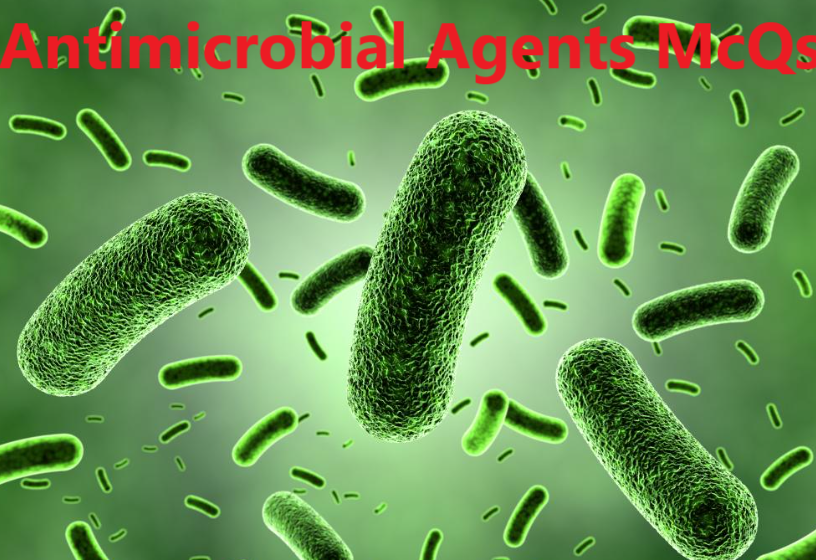Antimicrobial Agents Multiple Choice Questions
1. The mechanism of action of Trimethoprim is:
A. Inhibition of enzyme dihydropteroate synthetase
B. Activation of enzyme dihydrofolate reductase
C. Inhibition of enzyme dihydrofolate reductase
D. Activation of enzyme dihydrofolate reductase
2. All of the following combinations are true, except:
A. Ciprofloxacin: inhibition of DNA gyrase
B. Polymyxin B: inhibition of 50s protein synthesis
C. Erythromycin: inhibition of 50s protein synthesis
D. Sulphonamide: inhibition of folic acid
3. Which of the following antibiotics acts by inhibiting nucleic acid synthesis?
A. Penicillin
B. Quinolones
C. Sulphonamides
D. Cephalosporin
4. Followings are the second-generation quinolones, except?
A. Gatifloxacin
B. Enoxacin
C. Ofloxacin
D. Ciprofloxacin
5. Which of the followings are the drug interactions of quinolones is correct?
A. Antacids and calcium supplements decrease the absorption of quinolones
B. Quinolones enhance the metabolism of theophylline
C. Antacids, and calcium supplements increase absorption of quinolones
D. Increased metabolism of warfarin and caffeine
6. Cotrimoxazole is a combination of drugs
A. Sulphonamide + Chloramphenicol
B. Sulphonamide + Lincomycin
C. Sulphonamide + Trimethoprim
D. Sulphonamide + Tetracycline
7. Following adverse effects shown by the corresponding drugs are true, except?
A. Chloramphenicol: gray baby syndrome
B. Cefoperazone: disulfiram-like reactions
C. Tetracycline: Fanconi syndrome
D. Sulphonamide: red man syndrome
8. The following statement about quinolones is true, except?
A. Inhibition of DNA gyrase
B. Gemifloxacin and Clinafloxacin are 4th generation quinolone
C. Norfloxacin is 1st generation quinolone and used in the treatment of UTI
D. Second generation quinolone has increased activity against gram-positive bacteria including S. pneumoniae
9. Ciprofloxacin should not be used with theophylline because……………………………………………..
A. It decreases the efficacy of theophylline
B. It increases the toxicity of theophylline
C. Decreases absorption of theophylline
D. Decreases the efficacy of ciprofloxacin
10. Prolonged therapy of …………………………… leads to the development of pseudomembranous colitis
A. Amikacin
B. Clindamycin
C. Streptomycin
D. Vancomycin
11. By binding to the fungal ergosterol and altering its cellular permeability is the mechanism of action of ……………………….
A. Ketoconazole
B. Griseofulvin
C. Clotrimazole
D. Amphotericin B
12. Most commonly used topical antifungal for suppression of local candida infection is ………………………..
A. Miconazole
B. Fluconazole
C. Nystatin
D. Flucytosine
13. The type of drug interactions between flucytosine and amphotericin B is ………………………
A. Synergism
B. Antagonism
C. Potentiation
D. Additive
14. Which antifungal acts by non-competitive inhibition of squalene epoxidase thereby inhibiting ergosterol synthesis?
A. Flucytosine
B. Griseofulvin
C. Terbinafine
D. Ketoconazole
15. For the treatment of tinea cruris and tinea corporis, which topical allylamine(s) can be used?
A. Terbinafine
B. Naftifine
C. Both A & B
D. None of the above
16. Gynecomastia and menstrual irregularities are the adverse effects of …………………………
A. Terbinafine
B. Flucytosine
C. Griseofulvin
D. Ketoconazole
17. All of the followings are the correct combination of drugs and their mechanism of action, Except
A. Polyenes: binds to and disrupt the fungal cell membrane
B. Griseofulvin: blocks intracellular microtubules
C. Allylamines: inhibition of squalene epoxidase and blocks ergosterol formation in the cell membrane
D. Flucytosine: inhibition of cytochrome P450 dependent 14 α-demethylase and blocks ergosterol formation in the cell membrane
18. Flucytosine acts by
A. Inhibition of thymidylate synthetase leading to inhibition of DNA synthesis
B. Disruption of the mitotic spindle during metaphase by interacting with fungal microtubules
C. Inhibition of squalene epoxidase and blocks ergosterol formation in the cell membrane
D. None of the above
19. The most potent azoles antifungal is ………………….
A. Itraconazole
B. Fluconazole
C. Ketoconazole
D. Miconazole
20. Followings are the drug interactions of Ketoconazole, except?
A. Inhibition of the metabolism of cyclosporine thereby increasing its toxicity
B. Enhanced metabolism of Astemizole and Terfenadine thereby decreasing arrhythmias
C. Cimetidine interferes with Ketoconazole absorption by increasing gastric pH
D. Rifamycins increase Ketoconazole hepatic metabolism
